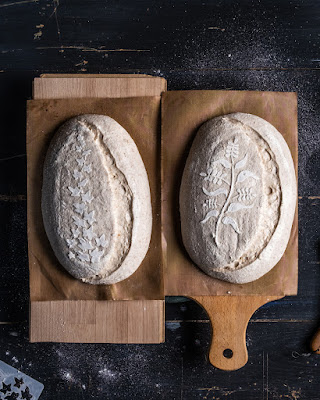First time I tried it I was not very happy with its dough structure and I over fermented it. The bread was perfectly eatable but for sure, was not what I expected it to be.
With the lessons learned from this first failed attempt, I focused on improving 2 things: dough handling and reduced fermentation time while keeping the list and quantity of ingredients exactly the same. To build a better structure, I added a 4th coil fold. For the fermentation, I definitely understood that this combination of flours, had to have a higher ph than 4.15 (as my previous test was). I shaped it then at ph 4.33 and put it in the fridge at 4.25. Only these 2 changes transformed a recipe from zero to hero.This is a perfect example of improving the method and not changing the ingredients or their quantity. The method matters! There are many methods out there that make fantastic loaves of bread but you need to master yours and know the implications of changing it.
Ingredients: (1782g, 78% hydration)
180 g sourdough starter (100% hydration)- 180g whole wheat flour (baker's %: 20%)
- 221g spelt flour (baker's %: 24.5%)
- 500g strong bread flour
- 683g water (divided in 2 parts: 500g + 183g)
- 18g salt
Directions:
- [Day 1, Friday, 23:00] Scaling. Start by scaling your ingredients using a balance and put them on the table to ensure that nothing is forgotten.
- In a bowl, mix the whole wheat flour with 183ml of water. Cover the bowl and let it sit overnight in a cool place (<15ºC). If it is too warm, put it in the fridge. I also feed my starter now, to be ready for the next day: 20g of starter + 80g of water + 80g of bread flour = exactly the quantity I need in the morning for my dough)
- [Day 2 Saturday, 8:00] Mix water + flours. Mix only the bread flour and spelt flour with water (slightly warmed up for 1 minute in the microwave) until well combined. Do not knead at this stage, just ensure there is no unincorporated dry flour resting in the bowl and that's it. I put this dough in the bread proofer set at 28ºC and I also add the bowl with the whole wheat mini dough to warm. I then let them both sit for 90 minutes.
- [Day 2 Saturday, 9:30] Sourdough starter. Add the preferment over the dough and the whole wheat dough and mix by hand or with a standing mixer for 10 minutes. After mixing, let the dough relax for 1 hour.
- [Day 2 Saturday, 10:30] Salt. Add the salt and mix again for 5 minutes. Then, let the dough relax again for 1 hour.
- [Day 2, Saturday, 11:30] Divide and Stretch and Fold. Take the dough out of the bowl put it on the slightly wet table board and divide it into 2. Stretch and fold each piece on the board and place them in squared glass bowls. Let them sit covered for 1 hour.
- [Day 2, Saturday, 12:30] Lamination. Take each piece out of the bowl and do the lamination. Let the dough rests for 45 minutes.
- [Day 2, Saturday, 13:15] Coil fold 1. Start now a set of 4 coil folds performed straight in the bowls. Do the first coil fold set in each glass bowl and let them sit for 45 minutes.
- [Day 2, Saturday, 14:00] Coil fold 2. Do a second set of coil folds in the glass bowls and let them sit for 45 minutes.
- [Day 2, Saturday, 14:45] Coil fold 3. Do a third set of coil folds for each dough and let them sit for 45 minutes.
- [Day 2, Saturday, 15:30] Coil fold 4. Do a fourth set of coil folds for each dough and let them sit for 30 minutes.
- [Day 2, Saturday, 16:00] Shape the loaves on the lightly floured board. Place the dough face down into well-floured bannetons. Repeat the process for the second piece of dough. [PH 4.33, DT 22ºC]. Leave the dough in the bannetons for 45 minutes more and place it in the fridge overnight. [PH 4.25, DT 21ºC]
- [Day 3, Sunday, 9:00] Score. Before scoring, you need to preheat the oven and the baking stone at 275ºC.
Take the dough out from the fridge and reverse the banneton on baking paper. Score and decorate the bread as you like. Immediately after, slide the loaves over the hot stone and create steam. - Bake at 270ºC for 15 minutes then reduce the oven temperature to 220ºC and continue to bake for 25 minutes.
- [Day 3, Sunday, 9:40] Cool. The bread needs to cool for at least 2 hours until it reaches room temperature. The cooking process continues slowly even after taking the bread out of the oven, so this is why it is important to not skip this step and to resist cutting it too early. If you can, of course...
- [Day 3, Sunday, 11:40] Cut. Now is the big moment to enjoy a slice of bread...












0 comments:
Post a Comment